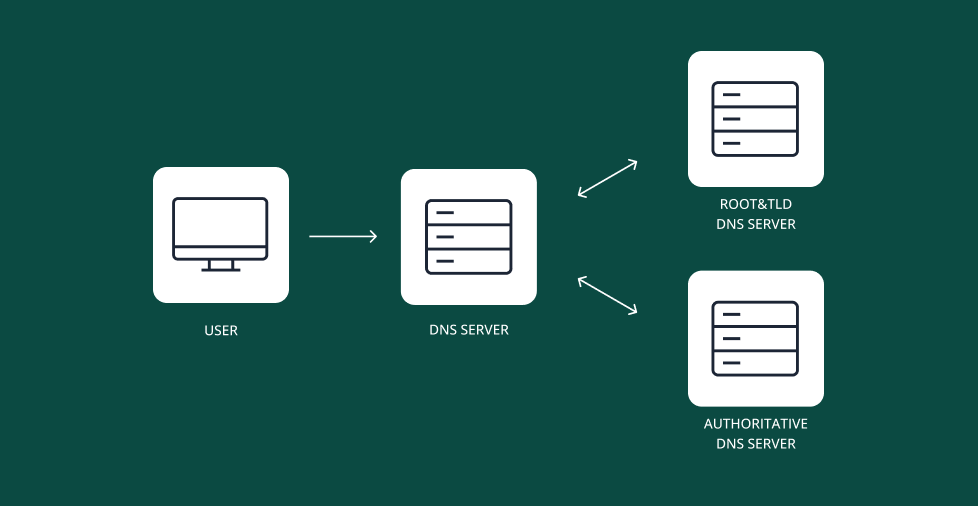Key takeaways:
- DNSSEC enhances the security of DNS by preventing attacks like spoofing and tampering.
- Implementing DNSSEC may seem complex, but it’s a manageable process that can be done with the right guidance.
- DNSSEC ensures that online threats can’t alter your DNS data or redirect users to fraudulent websites.
Every time someone types in your domain, the domain name system (DNS) translates that name into an IP address to load your site. But this process isn’t always built with security in mind. This makes it vulnerable to tampering, redirection, and spoofing attacks. That is where the domain name system security extensions (DNSSEC) step in.
In this article, we’ll walk you through how DNSSEC validation works, why it matters for your website, and how you can set it up to protect your domain from online threats.
What is DNSSEC and how does it work?
DNSSEC is a security protocol designed to protect the integrity of the information your website sends to browsers. It adds a digital signature to DNS resource records that help ensure that the information your visitors receive hasn’t been altered or tampered with by hackers or attackers.
To make this work, DNSSEC uses a pair of cryptographic keys:
- Private key. This secret key stays with your DNS host. It’s used to create a digital signature for each DNS record.
- Public key. This is shared publicly in the DNSKEY record. It’s what resolvers use to check that the signature is valid.
The digital signature is then saved in a special DNS record type called resource record signature (RRSIG). It holds the cryptographic signature and proves the DNS data hasn’t been tampered with. The key that checks this signature is stored in a DNSKEY record in which the public key is located.
These DNSSEC keys confirm that the DNS data is authentic and wasn’t altered during the process. If something’s off, the signature won’t match, and the browser will know not to trust it.
DNSSEC: Chain of trust
To make sure DNS data is trustworthy, DNSSEC creates a “chain of trust” that connects each level of the DNS protocol, from the DNS root zone to your domain.
Here’s how it works:
- The zone signing key (ZSK) signs your domain’s DNS records to confirm they’re real.
- The key signing key (KSK) signs the zone signing key to prove it’s trustworthy.
The DNS process works like a chain of trust, where each level checks the one below it. It starts at the root, then checks the top-level domain like .com, and finally your domain. Each step confirms that the next one is valid and secure. If anything’s altered along the way, the browser knows it’s not trustworthy and will reject the data.
Why is DNSSEC important?
As online threats continue to grow, keeping your website secure is a top priority. Here are key reasons why DNSSEC is a great tool for your website:
- Protects against common DNS attacks
- Verifies DNS data authenticity and prevents tampering
- Builds trust and improves security for users
- Limits exposure to some cyber threats
- Works with your existing setup
Protects against common DNS attacks
DNSSEC helps protect against several common DNS-based attacks, including:
- DNS spoofing. Attackers can redirect users to fake websites by manipulating DNS records.
- DNS cache poisoning. Malicious persons can flood a DNS resolver with false information which leads users to incorrect or harmful websites.
- False zones. Attackers can exploit gaps between DNS zones to provide fake responses.
These attacks damage your website’s reputation and lead to data theft, malware infections, or phishing attempts. DNSSEC validation ensures the legitimacy of DNS responses before they reach users.
Verifies data authenticity and prevents tampering
DNSSEC ensures that the DNS data you receive is authentic and hasn’t been altered during transmission. It verifies the origin of the DNS data and ensures it comes from a legitimate source.
Without DNSSEC, hackers can alter DNS data and lead to malicious redirection or stealing sensitive information. DNSSEC prevents such tampering and maintains the integrity of DNS responses, boosting user confidence in your website.
Builds trust and improves security for users
When users visit your website, they trust that they are directed to the correct page. Without DNSSEC, attackers can redirect users to fake websites.
DNSSEC helps maintain this trust and ensures that users are directed to the authentic version of your site. This is crucial for websites handling sensitive information, like login credentials or payment details.
Implementing DNSSEC also improves your website’s trustworthiness, which indirectly benefits your SEO rankings by increasing user retention and lowering bounce rates.
Limits exposure to some cyber threats
While DNSSEC strengthens DNS security, it doesn’t protect against all cyber threats, such as distributed denial of service (DDoS) attacks. But it can help mitigate the effects of such attacks by ensuring the integrity of DNS data. This prevents attackers from using fake DNS records to launch a DDoS attack.
DNSSEC maintains the integrity of the DNS data and reduces the chances of attackers exploiting vulnerabilities, which can help minimize the impact of cyber threats on your website.
Works with your existing setup
DNSSEC is widely recognized as an essential security measure, with organizations like Internet Corporation for Assigned Names and Numbers (ICANN) actively promoting its adoption. Many top-level domains (TLDs) already support DNSSEC, and it’s becoming one of the standards for website security.
DNSSEC is compatible with existing DNS infrastructure, meaning it can be easily implemented without requiring major changes to your website’s network or hosting setup. This makes it a practical and effective way to improve your site’s security.
Why isn’t everyone using DNSSEC?
Although DNSSEC offers great security for websites and many TLDs support it, it’s not yet widely used. Here are key reasons why DNSSEC hasn’t been adopted by most businesses:
- It’s complicated to set up and manage
- The benefits aren’t immediately visible
- It depends on third-party services
- Adoption is uneven
It’s complicated to set up and manage
Setting up DNSSEC involves managing cryptographic keys like the ZSK and KSK, which can be tricky and require a bit of technical knowledge.
Website owners need to generate and manage special DNSSEC records. This process can be tedious and overwhelming for someone without experience in DNS management or handling DNS queries.
To properly implement DNSSEC, you need to add DS records to the parent zones (like .com or .org), which isn’t always a smooth process. Additionally, DNSSEC deployment requires coordinating with authoritative DNS servers, which can be complicated.
Finally, DNS signatures aren’t always generated automatically, which means domain owners may have to handle their own key management, which puts the risk of making mistakes in DNS request handling.
The benefits aren’t immediately visible
Unlike HTTPS, which shows a padlock in the browser, users don’t see any visual indicator that DNSSEC is being used. This makes it hard for website owners and users to notice the added security.
Many website owners may not be aware of its ability to prevent attacks like phishing, or they might not realize how important it is for protecting user data from manipulated DNS queries.
Since the benefits are not visible, it can be hard to justify the time and effort needed to set it up —especially if the immediate advantages of DNSSEC aren’t obvious in the context of their DNS security extensions.
It depends on third-party services
Another challenge with DNSSEC is that it relies on third-party DNS resolvers, such as Google Public DNS or Cloudflare, to validate the DNSSEC signatures.
If users are using resolvers that don’t support DNSSEC, then the added protection won’t work, even if the website has DNSSEC enabled. This dependency on third-party services can make it harder to ensure universal protection across all DNS requests.
Adoption is uneven
DNSSEC adoption varies by region. Some countries, like Sweden, have done well in adopting DNSSEC, but other parts of the world are much slower.
Managed DNSSEC deployment solutions can help large companies with the setup. However, it;s a bit more challenging for small businesses since they lack the resources or expertise to implement it properly, especially in managing authoritative DNS servers.
Plus, some argue that DNSSEC’s design hasn’t kept up with modern security needs, which is why some organizations have been hesitant to adopt it.
How to set up DNSSEC: Step-by-step guide
You don’t need to have any technical background or knowledge to set up DNSSEC for your website. Here’s a step-by-step guide to help you through it.
- Log in to your account with your domain registrar. Once you’re in, navigate to the dashboard where you can manage your domain settings.
- Locate the section for DNS settings. Look for the option related to DNSSEC, which may be listed under advanced settings or security features.
- In the DNS settings section, look for the option to enable DNSSEC. Once activated, it adds a layer of security by creating digital keys that help protect your domain from attacks.
- After enabling DNSSEC, you’ll receive a DS record. This record connects your domain’s security setup to the global DNS system.
- Some registrars handle this step automatically, but if not, you may need to copy and paste the DS record into your DNS settings. Double-check to ensure this step is completed.
- To make sure everything is set up correctly, use a trusted DNS diagnostic tool to verify that DNSSEC is working properly. This will confirm that your domain is now better protected against potential threats.
Implement DNSSEC for enhanced domain security
Managing your domain and setting up DNSSEC might sound complicated, but it’s actually easier than it seems. While there’s a bit of setup involved, DNSSEC is a great way to protect your website from attacks like DNS spoofing and cache poisoning. With the right guidance and process, you can get it up and running without too much hassle.
For a smoother experience, get secured with Network Solutions now! We offer SSL certificates and website security that keeps your site safe, ensures secure transactions, and builds trust with your visitors.
Frequently asked questions
No, DNSSEC is not outdated. While some argue it doesn’t cover all modern cyber threats, it still provides essential protection for DNS data integrity and remains relevant in preventing cyber-attacks.
The domain name system (DNS) converts human-readable domain names into IP addresses that lets users access websites. The domain name system security extensions (DNSSEC) add security to this process by ensuring that DNS records are legitimate and haven’t been tampered with during transmission.
ICANN is responsible for managing the root key signing key (KSK), which helps verify that DNS data is authentic. They also promote DNSSEC support, collaborate on improving security policies, and encourage the global use of DNSSEC to protect the internet from attacks.
Most major DNS providers support DNSSEC, but it only works if both your DNS host and domain registrar allow it. If either one doesn’t support DNSSEC, you won’t be able to enable it for your domain.
Yes, DNSSEC is useful even for smaller sites. It protects the integrity of your DNS records and highlights the importance of DNSSEC in preventing attackers from redirecting your traffic.
What DNSSEC is used for is to ensure that the data sent to your browser is legitimate and hasn’t been tampered with. Essentially, how DNSSEC works is that it adds a layer of security to the DNS process, ensuring your domain’s records are verified and protected.




